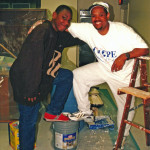Category Archives: Get to know our programs
The House That People Built
 In March 1969 Rex Smith, one of the original founders of Hearts & Homes for Youth, prepared a report called “The House That People Built: Anatomy of a Group Home in Suburbia.” The subject of the report was the Boys’ Home of Montgomery County, which is now known as Hearts & Homes for Youth.
In March 1969 Rex Smith, one of the original founders of Hearts & Homes for Youth, prepared a report called “The House That People Built: Anatomy of a Group Home in Suburbia.” The subject of the report was the Boys’ Home of Montgomery County, which is now known as Hearts & Homes for Youth.
In the report, a younger Rex describes Hearts & Homes for Youth’s (formerly named the Boys’ Home of Montgomery County) history, founding concept, and the anatomy of the program. It is heartwarming to read. Many of his words still ring true, such as his note in the Acknowledgements: “We appreciate very much the interest and enthusiasm of the local community without whose support as individuals, groups, and corporate citizens, there would be no home and no report.”
We have begun publishing excerpts from the report on our website and social media pages – we highly recommend that you take a look when you have time. Reading the reflections and observations of one of our original founders is a special way to get to know our programs and guiding values.
The House That People Built – Seeing a Need
The Concept of the Boys’ Home
The Program at the Boys’ Home
Get Involved!
Are you interested in getting involved with Hearts & Homes? We have plenty of opportunities for you to get engaged! As we help the youth prepare for summer when many of them will be looking for jobs, we are especially in need to volunteers to provide the following workshops:
- Financial literacy
- Resume writing
- Mock interviews
- Professional etiquette and hygiene
If you are interested in providing one of these workshops, mentoring our youth, or participating in the Princess Party or Kings of Style Party this summer, contact Caitlin Buckley at cbuckley@heartsandhomes.org – we look forward to hearing from you!
A look at the John C. Tracey Group Home for Boys
This month we want to tell you about Hearts & Homes for Youth’s John C. Tracey (JCT) Boys’ Home. JCT is a residential, community-based group home located in the heart of Rockville, Maryland. Here we provide delinquent adolescents and emotionally unstable adolescent males with consistent, discipline-building services that allow for personal growth and enrichment. The professional staff provides 24-hour supervision, nurturing, and care. Young men in this program typically spend up to two years in our home.
This group home offers support for up to eight adolescent males between the ages of 13 and 17 years old from all parts of Maryland. JCT Boys’ Home offers the following benefits:
- Individual, family, and group therapy targeted to building a strong personal identity, pride, self-esteem and confidence
- Employability development and placement with potential career development
- Educational advocacy and support, tutoring and college preparation
- Case management and coordination for health services, substance abuse treatment, and additional necessary services
- Recreation and constructive use of leisure time
- Life skills training to support self-sufficiency and independent living
- Anger management training and support services
JCT is run by Program Manager Ms. Tish, who is an extraordinary advocate for the youth in her care and remarkably dedicated to our mission. She works with the staff to build on their strengths to deliver the best services to youth at JCT.
The program at the Boys’ Home
In March 1969 Rex Smith, one of the original founders of Hearts & Homes for Youth, prepared a report called “The House That People Built: Anatomy of a Group Home in Suburbia.” The subject of the report was the Boys’ Home of Montgomery County, which is now known as Hearts & Homes for Youth. Here are some excerpts from the report.
The program of the homes is designed to be flexible enough to meet every aspect of the youngsters day to day life, always with any eye toward the future and a plan of smooth transition either back to his own home or toward more full independence within the community. The Boys’ Home program is interested in three interrelated services:
- The development of maturity and responsibility of each boy;
- Family counseling; and
- Follow-up services to former residents and their families
With the assistance of the referring agent, be it the Juvenile Court Probation Officer, the Department of Social Services Social worker, or the Pupil Services Worker, a planned program is established for each youngster prior to his entering into the home, again considering the length of time this program must be in effect before his release. A program as set up thus far has emphasized a relatively short-term stay in the home, averaging six months to nine months, with a maximum of one year.
The Boys’ Home approach is aimed at developing individual responsibility. The youngster will have duties and assignments as appropriate in the development of self-initiative and self respect. The Boys’ Home will involve to greater of lesser degrees every social service agency and resource within the community that has offered its services as part of its total responsibility for youngsters…
The most dynamic and important part of the Boys’ Home program involves the development of a significant and meaningful relationship between the counselors and the boys themselves.
“These boys are good boys. In most cases all they need is to know that someone loves them and cares what happens to them.” -Mrs. Gipe, Former Housemother
Mrs. Gipe continued, saying “To be awakened in the morning or just to sit on the bed and talk with them for a few minutes, usually gets them up. but once in a while we get a sleepy head that nothing short of a glass of water will work. I might say that after one experience of getting water in their faces, I do not usually have any more trouble getting them up. Surprisingly, they do not get too upset about it. Of course, they know that this could happen. Sometimes I think that they just try me to see if I will really do it”…
Normally one would not think of the home environment as being part of the program. We would ordinarily think of it as being part of our overall concept, but without the need for planning a home atmosphere. Not that we must program the homelike atmosphere but maintenance of our integrity about it being a home atmosphere is often challenged, not only by critics who would rather see a stockade-like structure, but also by the boys who quite often don’t know how to react to the relative tolerance and freedom of the home situation. The reactions by some of the boys is an overindulgence because of the relative tolerance. The reaction of the others used to rigid and restrictive living conditions really puts us on our mettle in trying to maintain the “home.”
Those so unused to what we might call a normal home setting where there is a lot of give and take and opportunity for making mistakes and taking responsibility, do engage in testing our home to see what it’s all about. The counselors are quite involved in helping the youngsters to redefine themselves with regard to our home situation and reduce their confusion. It would be very easy for us as a staff to fall into the pit of reacting to these testing situations by increasing tenfold our rules and regulations, which would in fact move us closer to being an institutional setting rather than a home setting. We have always emphasized with the boys from the very first day and repeatedly throughout their stay, that this home of ours is just that, and that we have no bars, no locks, and if they were of a mind to get up and walk out, we will not call the police or otherwise detain them. Our emphasis is on wanting to make them feel at home so that they do not have to have desires to leave. If a young man decides to “blow up” and leave the home, we are more inclined to reduce his anger and high-pitched feelings by discussion of what the home has meant to him and what he has meant to us. This has arisen on occasion, particularly when a youngster nears release. Quite frankly this has been effective and we have avoided attempts by the boys, at least subconsciously, to have us put bars around them…
The development of an identity with the boys home by each of the youngsters as a place for them to call their own has been quite significant in this regard. Each boy knows that he could walk out at any time and would not be physically withheld or “collared” by one of the counselors, but he also knows that they will give him time and an ear so that he can express himself about whatever he feels is important at the moment…
Some observers feel quite concerned that the home does not have a rulebook for each youngster to look at and read and understand, or a “sign in” and “sign out” sheet so that we will know every moment where every youngster is. If we are to maintain a homelike atmosphere then we cannot get in the business of developing institutional mechanisms… It is with the judges consent that he be placed in the home, in the community…
Finding a forever family
Family isn’t always blood. It’s the people in your life who want you in theirs. The ones who accept you for who you are. The ones who would do anything to see you smile, and who love you no matter what.
– Unknown
One of the dreams of many foster youth is simple, to be connected with others who will care about them; not just right now but a forever family who is also there down the line when they make the scary transition into adulthood at the young age of 21. When many youth emancipate from foster care once they turn 21, they are forced to make decisions and choices without the safety net of a family standing behind them that many of us had at the same age, and the consequences if they head in the wrong direction are much greater. Think about when you were 21 and had a question about some of the scary things about being an adult such as how much your electric bill should be, guidance on how to shop for your first apartment or a shoulder to cry on when you got into your first car accident. Most of us had an adult in our corner to support us when things got rough.
For one of our youth, she has found a forever family in her former foster mother. Lashina entered our Family Ties Therapeutic Foster Care Program as a teen and entered the foster home of Ms. Joyner the summer before she aged out of foster care. Although she was only in her home for a short time, the bond between Lashina and Ms. Joyner was immediate and when she left Ms. Joyner’s home at the age of 21, Lashina knew that if things got rough, she would have Ms. Joyner to turn to. In Ms. Joyner, Lashina had found a forever family. After staying with friends for a few months, Lashina found herself in a bad situation with nowhere to turn and called Ms. Joyner for advice. Ms. Joyner’s advice to Lashina was to come home, so she did. Today, Lashina continues to reside with Ms. Joyner as she gets back on her feet and figures out what she plans to do with her future. For Lashina and Ms. Joyner, the bond they formed did not end when Lashina turned 21; they are now and forever will be a family.
Are you thinking about being a foster parent?
Click here to learn more!
The concept of the Boys’ Home
In March 1969 Rex Smith, one of the original founders of Hearts & Homes for Youth, prepared a report called “The House That People Built: Anatomy of a Group Home in Suburbia.” The subject of the report was the Boys’ Home of Montgomery County, which is now known as Hearts & Homes for Youth. Here are some excerpts from the report.
The concept of the Boys’ Home involves an understanding that there are youths in the community who are in need of professional guidance and supervision but for various reasons cannot be worked with in their home. Before Boys’ Home there was no alternative program to a training school commitment or an ill-advised placement on probation. It makes good sense that if we are to treat the behavior problems of these troubled youth we must treat them in their entirety. This means working with the youngsters’ family, school, and community – a task that cannot be accomplished if the young person does not reside within the community itself.
The Boys’ Home is interested in working with youth and family, toward a better understanding, acceptance, and respect for the other. The concept itself, that of a small group residence of eight to ten youngsters, is not to be aborted. The integrity of maintenance of the small setting in a homelike atmosphere is an ultimate concern. The group home for these youngsters is not conceived of as being a high-powered psychiatric facility. Youngsters who are seriously disturbed and in need of intensive psychiatric treatment would not be admitted to the Home. Although we realize the nature of these problems and the need for a residential treatment center, the relative freedom of taking responsibility for oneself in a group home is not conducive to these children. The home will have youngsters with particular behavior problems resulting in difficulties in the home and in the school, perhaps even the community. For the purposes of staff training, provision for psychiatric consultation is made.
The group home cannot satisfy all levels of behavior disturbance for all youngsters. The community must be aware that in addition to group homes it must provide a variety of other services to meet the needs of many youngsters who cannot profit from the group home setting. The concept involves what has been termed by professionals as the “therapeutic milieu,” which means that by having to deal with others in his peer group from similar backgrounds and with similar problems, the youngster learns to deal more effectively with his own personal concerns. In addition, the youngster learns to deal more effectively with a compassionate and stable staff while working out his problems, which often result in a heightened level of anxiety and perhaps even “acting out” in the home.
The nature of the Boys’ Home itself allows for a high degree of tolerance for this type of behavior and a greater degree of understanding on a professional level than does ones own home where such behavior can be disrupting to parents and other children.
The House that People Built – Seeing a need
In March 1969 Rex Smith, one of the original founders of Hearts & Homes for Youth, prepared a report called “The House That People Built: Anatomy of a Group Home in Suburbia.” The subject of the report was the Boys’ Home of Montgomery County, which is now known as Hearts & Homes for Youth. Here are some excerpts from the report.
"We appreciate very much the interest and enthusiasm of the local community without whose support as individuals, groups, and corporate citizens, there would be no home and no report." -Rex Smith
The history of progress in the human service area often revolves around a tragic accident…
There was in our history, a single case in point that brought attention to the seriousness of this problem, which had not yet been brought to public attention through tragedy. This case occurred in the adult court regarding a youth of nineteen years. Mr. Melvin M. Feldman, later to become the President of the Board of Directors of the Boys’ Home, was appointed to the case of the youth, who was without family or other resources.
The judge, based on Mr. Feldman’s investigation, did not want to commit the boy to a reformatory, but found himself in a quandary. Mr. Feldman, a man of action, got in touch with several people who eventually led him to Reverend David Watterworth, then Pastor of the Georgia Avenue Christian Church in Silver Spring, MD. Arrangements were made for Reverend Watterworth to take the young lad into his own home where he remained for the next several months until he went out on his own. There were no incidents of offensive behavior recorded during his period of stay with the Watterworth family.
Neither Mr. Feldman nor Reverend Watterworth were satisfied with the facilities available for youngsters in difficulty. They both involved the Honorable Alfred D. Noyes, Judge of the Juvenile Court for Montgomery County, in an effort to develop a plan for the establishment and operation of youth homes throughout the county. These homes would be capable of dealing with youngsters who were in trouble and/or from troubled homes, who would benefit from a residential experience with other youngsters. Here they would have the opportunity for education, vocational training, and work experience.
Mr. Feldman called together a group of thirteen people on the evening of February 24, 1964 to further discuss the dilemma facing the courts. The group discussed the “half-way house” concept and set out fact-finding committees to determine how financial assistance could be developed, as well as the intent and scope of the program, which would be established in the home. Several committees were set for various purposes with major emphasis centered around the development of community interest in the youngsters and the program.
The group decided to incorporate itself as the Boys’ Home of Montgomery County on April 17, 1964. During the next few months, one of the committees developed a liaison with and a commitment from the various social service agencies in the community toward helping the Boys’ Home. These included the Probation Department of the Juvenile Court, the Department of Public Welfare, the Division of Child Mental Health, the Board of Education Pupil Services Division, the Department of Vocational Rehabilitation for the State of Maryland, the Family Services Agency of Montgomery County, the Probation Department of the Circuit Court, the Department of Employment Security, and the Bureau of Rehabilitation of the National Capital Area. There was little doubt that the social serving agencies who dealt with adolescent youth everyday considered this a major project.
An investigation and study of probation cases in the Juvenile Court in 1964 found that at least one hundred young men between the ages of 16 and 19 who appeared before the Juvenile Court in Montgomery County would have been referred for placement in a structured homelike setting. It was clear that many adolescent youth in the community needed residential treatment and placement outside of their own homes but not in a mental hospital or in training school settings. The Maryland State Department of Public Welfare had held a conference as far back as 1961 on halfway houses. The need to provide this type of residential treatment in the State of Maryland was cited time and time again with as yet no results. Judge Alfred Noyes stated:
“I have no doubt that it could help save many boys from a life of crime… The court in most instances is confronted with a choice offering either probation services or commitment to one of the State training schools. There should be alternative facilities such as small group homes where children could live in a homelike atmosphere under the supervision of competent personnel and receive probation services from the staff of Court.”
On February 12, 1968 we opened the doors of the Boys’ Home… We had arranged for contractual spaces, that is, four bedrooms on the upper floor of a large old home in Rockville, which was used as a boarding house for adults. A part-time counselor was hired and with the help of the owner of the home who acted as a cook and housekeeper, and the probation staff, we were able to develop a shoestring approach to the guidance and development of the youngsters who were referred to us by the Juvenile Court.
In May of 1968 we learned of the foresight and conscientious concern of the Montgomery County Council for the Boys’ Home… the County Council appropriated $30,000 in its 1968-69 budget to match the money raised by the Boys’ Home. This $30,000 would help pay for at least one half of the cost of care, per boy, per month. This single action by the Montgomery City Council was probably the most significant in our development. We were a reality, but this acceptance of our integrity by the governing body of the County seemed to push us over the hump.
At this writing, our history is in fact history. We are by no means on easy street and, as mentioned before, our existence from year to year will be as much based on the grass roots $5 membership from individual citizenry as on larger contributions from major corporations and foundations. We started on nickels and dimes raised at the Montgomery County Fair through the sale of balloons and other small but very significant contributions. Certainly we plan to better our organization and expand as part of our future. Our history as it can be read. however, makes us both humble and grateful.
Getting a jumpstart at our semi-independent living program
 Jumpstart Semi-Independent Living Program for Boys is a program designed to help youth jumpstart their lives. Located in bustling and artistic Hyattsville, Maryland, this historic home provides a structured, rigorous, and goal-oriented program for young men ready to embark as independent, mature community members. The program is structured around giving young men the freedom to make positive and sound choices, develop a sense of responsibility, and take control of their lives. With professional staff providing 24-hour supervision and behavioral role modeling, this program provides the consistency and continuity that allows our young men to develop skills necessary to become productive, responsible, and engaged community members.
Jumpstart Semi-Independent Living Program for Boys is a program designed to help youth jumpstart their lives. Located in bustling and artistic Hyattsville, Maryland, this historic home provides a structured, rigorous, and goal-oriented program for young men ready to embark as independent, mature community members. The program is structured around giving young men the freedom to make positive and sound choices, develop a sense of responsibility, and take control of their lives. With professional staff providing 24-hour supervision and behavioral role modeling, this program provides the consistency and continuity that allows our young men to develop skills necessary to become productive, responsible, and engaged community members.
Jumpstart group home offers support for up to eight adolescent males between the ages of 17 and 20 years old from all parts of Maryland. Individuals typically reside in the home for nine to twelve months, and up to two years. Jumpstart provides the following benefits:
- Individual, family, and group therapy targeted to building a strong personal identity, pride, self-esteem and confidence
- Employability development and placement with potential career development
- Educational advocacy and support
- Case management, referral and coordination for health services, substance abuse treatment, family therapy, and additional necessary services
- Recreation and constructive use of leisure time
- Life skills training to support self-sufficiency
From the moment a new resident arrives, staff at Jumpstart work to get them into school or a job and help the residents find their voices. Jumpstart staff explain that the young men need to learn that they have a choice every day to invest in themselves, and that staff at Jumpstart are listening.
While the youth are discovering their voices and developing their sense of responsibility, the Program staff have observed that the young men also need inspiration to get out of the house. “The time spent in detention teaches the boys to stay inside, we want to get them out and reconnected with the community.”
Group activities, like basketball games, are a great way for the youth to get to know each other and develop a sense of community. When the group plays basketball together, they are having fun, seeing the program staff like family members, and respecting each other.
Another group activity that the young men love is cooking. Most of the residents who come to the home say that they do not know how to cook. The boys tend to trail behind Mike when he goes into the kitchen. When he starts cooking, the boys start asking questions. He casually explains what he’s doing and asks for their help getting some spices or rinsing the meat, walking them through his recipe. Often he makes it a comical experience, pretending they are putting on a cooking show, so the youth enjoy it and get engaged.
Usually the young men at Jumpstart are employed or in school, or both, within a month of entering the program. Throughout their time at Jumpstart, staff give the young men positive reinforcement and recognize their talents, to help the youth realize what they bring to the table and the possibilities that are available to them.
“All the kids want is for you to spend some time with them. When they act out they just want someone to listen and engage with them. Sometimes the boys run away from the family environment staff creates at Jumpstart because they are not used to it. They self-sabotage because they are afraid of recognizing that someone cares.”
Nevertheless, the Jumpstart program staff are dedicated every day to helping the young men realize they have a voice, they are respected, they are heard, and they are supported. The goal of the program is for each young man to achieve success, change, and confidence and leave the program as independent, productive young adults.
Harriet Tubman Day – an activist and a humanitarian
 Today is the 98th anniversary of Harriet Tubman’s death in 1913. The date was designated as national Harriet Tubman Day in 1990.
Today is the 98th anniversary of Harriet Tubman’s death in 1913. The date was designated as national Harriet Tubman Day in 1990.
As for many, Harriet Tubman is an inspiration for everyone at Hearts & Homes. In her memory, we opened the Harriet Tubman Emergency Shelter in a targeted attempt to reduce the number of African-American young men being incarcerated in a lock-up, lock-down, detention center (juvenile jail) when they pose no serious threat to the community while awaiting a court hearing.
The youth that are placed at the Harriet Tubman shelter are referred to us by the Department of Juvenile Services. Hundreds of young men from across the state, amounting to thousands of days, have stayed at our shelter where they have received residential and supportive services.
Consistently, after being placed in our care, most of the young men went home or to a community based program or facility like the group homes we operate. It is clear everyday that believing in these young men, giving them the tools create opportunities for themselves, and supporting them in a home-like environment rather than locking them up, helps them get themselves back on the right track.
We call the shelter our “Over Ground Railroad to Freedom,” even Justice.
Ours is a living tribute to Harriet Tubman’s legacy as we celebrate now and for years to come, her courage and self-sacrifice, which led thousands to freedom. Ours is to lead thousands of youth to the freedom perhaps otherwise denied to them; to learn, to grow, to mature, and to become responsible adult citizens of the community. Ours is to provide a safe, secure, and disciplined shelter home; an opportunity to realize their potential and dreams. Ours is to purposefully interrupt the first stop on the train to criminalization – incarceration prior to juvenile court hearings of those who are not a threat to the community. Ours is to put them on a train to a bright, productive future. Yours is to help us keep that train on the right track. Bless you, Rex Smith










